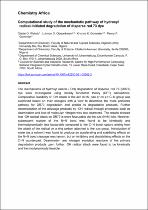 ResearchSpace
ResearchSpace
Computational study of the mechanistic pathway of hydroxyl radical-initiated degradation of disperse red 73 dye
JavaScript is disabled for your browser. Some features of this site may not work without it.
- ResearchSpace
- →
- Research Publications/Outputs
- →
- Conference Publications
- →
- View Item
| dc.contributor.author |
Wahab, OO

|
|
| dc.contributor.author |
Olasunkanmi, LO

|
|
| dc.contributor.author |
Govender, Krishna K

|
|
| dc.contributor.author |
Govender, PP

|
|
| dc.date.accessioned | 2022-02-25T09:22:09Z | |
| dc.date.available | 2022-02-25T09:22:09Z | |
| dc.date.issued | 2022-02 | |
| dc.identifier.citation | Wahab, O., Olasunkanmi, L., Govender, K.K. & Govender, P. 2022. Computational study of the mechanistic pathway of hydroxyl radical-initiated degradation of disperse red 73 dye. <i>Chemistry Africa, vol. 5(1).</i> http://hdl.handle.net/10204/12285 | en_ZA |
| dc.identifier.issn | 2522-5766 | |
| dc.identifier.issn | 2522-5758 | |
| dc.identifier.uri | https://doi.org/10.1007/s42250-021-00292-2 | |
| dc.identifier.uri | http://hdl.handle.net/10204/12285 | |
| dc.description.abstract | The mechanisms of hydroxyl radical (·OH) degradation of disperse red 73 (DR73) dye were investigated using density functional theory (DFT) calculations. Comparative feasibility of ·OH attack at the azo (N=N) site or on a > C–N group was examined based on their energies with a view to determine the more preferred pathway for DR73 degradation and predict its degradation products. Further decomposition of the cleavage products by ·OH radical through processes such as deamination and loss of molecular nitrogen was also examined. The results showed that ·OH radical attack on DR73 is more favourable via the azo (N=N) site. However, subsequent rupture of the N=N bond was found to be kinetically and thermodynamically less favourable compared to the C–N bond rupture arising from the attack of the radical on a ring carbon attached to the azo group. Introduction of water (as a solvent) was found to produce an accelerating and stabilising effects on the N=N bond cleavage mechanism, but an inhibitory and destabilising effects on the C–N counterpart. Deamination and nitrogen evolution reactions of the primary degradation products upon further ·OH radical attack were found to be kinetically and thermodynamically feasible. | en_US |
| dc.format | Abstract | en_US |
| dc.language.iso | en | en_US |
| dc.relation.uri | https://link.springer.com/article/10.1007/s42250-021-00292-2 | en_US |
| dc.source | Chemistry Africa, vol. 5(1) | en_US |
| dc.subject | Degradation mechanisms | en_US |
| dc.subject | Density functional theory | en_US |
| dc.subject | DFT | en_US |
| dc.subject | Disperse red 73 | en_US |
| dc.subject | Hydroxyl radical | en_US |
| dc.subject | Solvent effect | en_US |
| dc.title | Computational study of the mechanistic pathway of hydroxyl radical-initiated degradation of disperse red 73 dye | en_US |
| dc.type | Article | en_US |
| dc.description.pages | 135-148 | en_US |
| dc.description.note | © The Tunisian Chemical Society and Springer Nature Switzerland AG 2021. Due to copyright restrictions, the attached PDF file only contains the abstract of the full text item. For access to the full text item, please consult the publisher's website: https://link.springer.com/article/10.1007/s42250-021-00292-2 | en_US |
| dc.description.cluster | National Integrated Cyber InfraStructure | en_US |
| dc.description.impactarea | CHPC | en_US |
| dc.identifier.apacitation | Wahab, O., Olasunkanmi, L., Govender, K. K., & Govender, P. (2022). Computational study of the mechanistic pathway of hydroxyl radical-initiated degradation of disperse red 73 dye. <i>Chemistry Africa, vol. 5(1)</i>, http://hdl.handle.net/10204/12285 | en_ZA |
| dc.identifier.chicagocitation | Wahab, OO, LO Olasunkanmi, Krishna K Govender, and PP Govender "Computational study of the mechanistic pathway of hydroxyl radical-initiated degradation of disperse red 73 dye." <i>Chemistry Africa, vol. 5(1)</i> (2022) http://hdl.handle.net/10204/12285 | en_ZA |
| dc.identifier.vancouvercitation | Wahab O, Olasunkanmi L, Govender KK, Govender P. Computational study of the mechanistic pathway of hydroxyl radical-initiated degradation of disperse red 73 dye. Chemistry Africa, vol. 5(1). 2022; http://hdl.handle.net/10204/12285. | en_ZA |
| dc.identifier.ris | TY - Article AU - Wahab, OO AU - Olasunkanmi, LO AU - Govender, Krishna K AU - Govender, PP AB - The mechanisms of hydroxyl radical (·OH) degradation of disperse red 73 (DR73) dye were investigated using density functional theory (DFT) calculations. Comparative feasibility of ·OH attack at the azo (N=N) site or on a > C–N group was examined based on their energies with a view to determine the more preferred pathway for DR73 degradation and predict its degradation products. Further decomposition of the cleavage products by ·OH radical through processes such as deamination and loss of molecular nitrogen was also examined. The results showed that ·OH radical attack on DR73 is more favourable via the azo (N=N) site. However, subsequent rupture of the N=N bond was found to be kinetically and thermodynamically less favourable compared to the C–N bond rupture arising from the attack of the radical on a ring carbon attached to the azo group. Introduction of water (as a solvent) was found to produce an accelerating and stabilising effects on the N=N bond cleavage mechanism, but an inhibitory and destabilising effects on the C–N counterpart. Deamination and nitrogen evolution reactions of the primary degradation products upon further ·OH radical attack were found to be kinetically and thermodynamically feasible. DA - 2022-02 DB - ResearchSpace DP - CSIR J1 - Chemistry Africa, vol. 5(1) KW - Degradation mechanisms KW - Density functional theory KW - DFT KW - Disperse red 73 KW - Hydroxyl radical KW - Solvent effect LK - https://researchspace.csir.co.za PY - 2022 SM - 2522-5766 SM - 2522-5758 T1 - Computational study of the mechanistic pathway of hydroxyl radical-initiated degradation of disperse red 73 dye TI - Computational study of the mechanistic pathway of hydroxyl radical-initiated degradation of disperse red 73 dye UR - http://hdl.handle.net/10204/12285 ER - | en_ZA |
| dc.identifier.worklist | 25382 | en_US |





